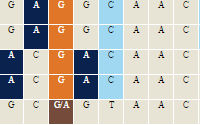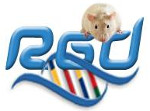GENE - CHEMICAL INTERACTIONS REPORT
Note: Use of the qualifier "multiple interactions" designates that the annotated interaction
is comprised of a complex set of reactions and/or regulatory events, possibly involving
additional chemicals and/or gene products.
Object Symbol | Qualifier | Evidence | With | Reference | Source | Notes | Original Reference(s) | PPARG | affects activity | EXP | | 6480464 | CTD | Cadmium Chloride affects the activity of PPARG protein | PMID:25596134 | PPARG | multiple interactions | EXP | | 6480464 | CTD | [Cadmium Chloride results in increased abundance of Cadmium] which results in decreased expression of PPARG protein; [Cadmium Chloride results in increased abundance of Cadmium] which results in increased expression of PPARG mRNA; MitoTEMPO inhibits the reaction [[Cadmium Chloride results in increased abundance of Cadmium] which results in decreased expression of PPARG protein]; PPARG protein inhibits the reaction [[Cadmium Chloride results in increased abundance of Cadmium] which affects the localization of RELA protein]; PPARG protein inhibits the reaction [[Cadmium Chloride results in increased abundance of Cadmium] which results in decreased expression of ARG1 mRNA]; PPARG protein inhibits the reaction [[Cadmium Chloride results in increased abundance of Cadmium] which results in decreased expression of IL10 mRNA]; PPARG protein inhibits the reaction [[Cadmium Chloride results in increased abundance of Cadmium] which results in decreased expression of PDGFB mRNA]; PPARG protein inhibits the reaction [[Cadmium Chloride results in increased abundance of Cadmium] which results in decreased expression of TGFB1 mRNA]; PPARG protein inhibits the reaction [[Cadmium Chloride results in increased abundance of Cadmium] which results in decreased phosphorylation of STAT6 protein]; PPARG protein inhibits the reaction [[Cadmium Chloride results in increased abundance of Cadmium] which results in increased expression of HIF1A protein]; PPARG protein inhibits the reaction [[Cadmium Chloride results in increased abundance of Cadmium] which results in increased expression of NOS2 mRNA]; PPARG protein inhibits the reaction [[Cadmium Chloride results in increased abundance of Cadmium] which results in increased expression of TNF mRNA]; PPARG protein inhibits the reaction [[Cadmium Chloride results in increased abundance of Cadmium] which results in increased phosphorylation of and affects the localization of STAT1 protein] | PMID:32917723 PMID:35301059 PMID:36602393 | PPARG | decreases expression | ISO | Pparg (Rattus norvegicus) | 6480464 | CTD | Cadmium Chloride results in decreased expression of PPARG mRNA | PMID:25993096 | PPARG | decreases expression | ISO | Pparg (Mus musculus) | 6480464 | CTD | Cadmium Chloride results in decreased expression of PPARG mRNA; Cadmium Chloride results in decreased expression of PPARG protein | PMID:23921151 PMID:31152847 | PPARG | increases expression | ISO | Pparg (Rattus norvegicus) | 6480464 | CTD | Cadmium Chloride results in increased expression of PPARG protein | PMID:28283887 | PPARG | increases expression | ISO | Pparg (Mus musculus) | 6480464 | CTD | Cadmium Chloride results in increased expression of PPARG mRNA | PMID:26352046 | PPARG | multiple interactions | ISO | Pparg (Rattus norvegicus) | 6480464 | CTD | [[sodium arsenite co-treated with lead acetate co-treated with Cadmium Chloride] results in increased phosphorylation of and results in increased activity of PPARG protein] which results in decreased expression of GFAP protein; [Cadmium Chloride co-treated with sodium arsenite] results in increased expression of PPARG protein; [lead acetate co-treated with Cadmium Chloride] results in increased expression of PPARG protein; [lead acetate co-treated with sodium arsenite co-treated with Cadmium Chloride] results in increased expression of PPARG protein; [sodium arsenite co-treated with lead acetate co-treated with Cadmium Chloride] promotes the reaction [CDK5 protein results in increased phosphorylation of PPARG protein]; [sodium arsenite co-treated with lead acetate co-treated with Cadmium Chloride] promotes the reaction [PPARG protein binds to GFAP promoter]; [sodium arsenite co-treated with lead acetate co-treated with Cadmium Chloride] results in increased phosphorylation of and results in increased activity of PPARG protein; CR8 compound analog inhibits the reaction [[sodium arsenite co-treated with Cadmium Chloride co-treated with lead acetate] results in increased expression of PPARG protein]; CR8 compound inhibits the reaction [[sodium arsenite co-treated with lead acetate co-treated with Cadmium Chloride] results in increased phosphorylation of PPARG protein]; PPARG protein affects the reaction [[sodium arsenite co-treated with lead acetate co-treated with Cadmium Chloride] results in increased expression of and results in increased cleavage of PARP1 protein]; PPARG protein affects the reaction [Cadmium Chloride results in increased cleavage of PARP1 protein]; pyrazolanthrone inhibits the reaction [[sodium arsenite co-treated with Cadmium Chloride co-treated with lead acetate] results in increased expression of PPARG protein]; T 0070907 inhibits the reaction [[sodium arsenite co-treated with lead acetate co-treated with Cadmium Chloride] results in decreased expression of PPARG protein]; T 0070907 inhibits the reaction [[sodium arsenite co-treated with lead acetate co-treated with Cadmium Chloride] results in increased phosphorylation of PPARG protein] | PMID:24481447 PMID:28283887 | PPARG | multiple interactions | ISO | Pparg (Mus musculus) | 6480464 | CTD | [Cadmium Chloride results in increased abundance of Cadmium] which results in increased expression of PPARG mRNA; [MT1 gene mutant form results in increased susceptibility to Cadmium Chloride] which results in decreased expression of PPARG mRNA; [MT2 gene mutant form results in increased susceptibility to Cadmium Chloride] which results in decreased expression of PPARG mRNA | PMID:23921151 PMID:36200916 | | ||||||||||||||||||||||
| Go Back to source page | Continue to Ontology report |



















